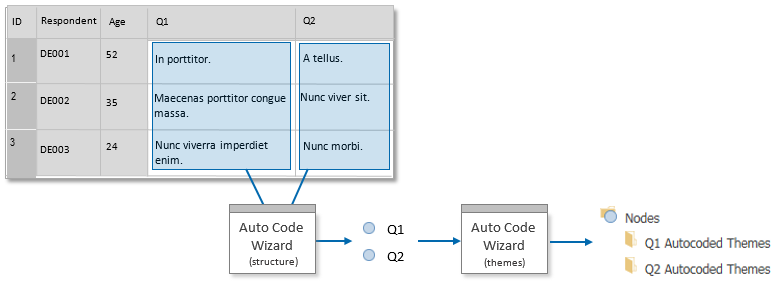About automated insights
This feature is available in NVivo Plus edition. Learn more
The term 'automated insights' in NVivo refers to the auto coding feature that automatically detects and codes themes or sentiment.
Use automated insights when you have limited time or large sets of data to develop preliminary results at the start of a project, or validate your thinking as you work. The automated insights functionality enables you to do approximate 'broad-brush' coding of large volumes of text quickly, which you can then review and refine.
In this topic
- Understand automated insights in NVivo
- Use automated insights as a discovery tool
- Use automated insights as a verification tool
- Limitations of automated insights
- Privacy of your data
- Projects in other languages
Understand automated insights in NVivo
Automated insights lets you work through large sets of data more efficiently—so you can get quick results to see what is happening in your content. You can focus less on the process of coding and more on the analysis of the results.
Automated insights is particularly useful if you have a very short time to form a broad conclusion. For example, a research consultant could quickly process public submissions to report findings in a timely manner during public consultation and program evaluation.
Be aware that there is a trade-off with automated insights—if time is paramount, you will get quick results but the results could be less accurate. If accuracy is paramount, you should code manually.
You do not need to have an understanding of data mining, text analytics or statistical methods and their terminology. There is no need to build up categories or criteria prior to running the analysis. The process involves selecting a set of sources and using the Auto Code Wizard to produce results. In a few simple steps, the Wizard makes it easy for you to gain an understanding of your data.
You can choose to auto code your sources and nodes for themes or sentiment.
Use automated insights as a discovery tool
Aimed at commercial and government researchers, automated insights provides a first-step in getting started in an NVivo project.
Bring in your sources, then auto code themes or sentiment as a first pass over the data. This will assign a broad categorization to the data and provide some initial building blocks for you to work with. This results may be sufficient to draw your attention to areas of interest. By auto coding themes you should be able to quickly discover patterns or trends in your source material.
Once you have some initial coding you can use the results to:
-
Code-on to develop ideas by coding content to other nodes.
-
Identify potential areas for deeper analysis.
-
Frame questions for further data collection.
For example, if you have a dataset of survey results, you might want to first auto code based on structure to create nodes for open-ended responses. Then use those nodes as input to auto code for themes.

In NVivo 11 (Update 2) introduced the Survey Import wizard which automates this process for you—coding survey responses to nodes then detecting themes and sentiment in the responses. Refer to Approaches to analyzing survey results for more information.
Use automated insights as a verification tool
Once you have done your own coding you could run automated insights to validate your thoughts. For example, automated insights may reveal elements within the data that you may have missed or overlooked. It can also act as 'another set of eyes' on your sources.
Since automated insights is computer-driven, the results are not influenced by your own bias.
Limitations of automated insights
Automated insights is not intended to replace the process of reading your source material. You still need to be familiar with your content to achieve meaningful research results. This feature is unlikely to be helpful when dealing with secondary data, for example, literature reviews.
Automated insights does not perform analysis on the results. You will need to perform further steps like running a matrix coding query to draw meaning from the results.
You cannot predetermine the themes that are searched for, and the 'stop word' list is not used when auto coding themes and sentiment.
Running automated insights doesn't limit your coding and you're not locked in to the results. The nodes are created in a designated folder, separate from your own nodes. You can move and merge nodes that result from auto coding themes, and you can easily change sentiment coding if you want to.
NOTE: There are some limitations when processing very large documents (or very large sets of documents) on the 32-bit version of NVivo. In this instance, install the 64-bit version of NVivo to use automated insights. You can see which version of software you are using on the About dialog box—refer to Software updates (Find out which version of the software is currently installed on your computer) for more information.
Privacy of your data
NVivo uses a proprietary tool to process the data—and the solution is fully integrated with NVivo. All data is held and processed within NVivo, so the security and privacy of your data remain within your control.
Projects in other languages
The automated insights functionality can only process one language at a time. This language is determined by the text content language setting of your project.
You should select sources of the same language to analyze, and then make sure they match your project text content language—refer to Set the text content language for more information. The following languages are supported:
-
Chinese (Simplified)
-
English
-
French
-
German
-
Japanese
-
Portuguese
-
Spanish
If your project text content language is set to "Other", you won't be able to use automated insights.
The automated insights process may produce different results in different languages. If you have a translated version of the same source, analyzing the French version in French and the English version in English may produce different results.


